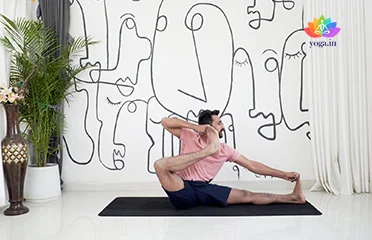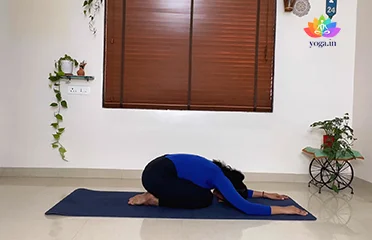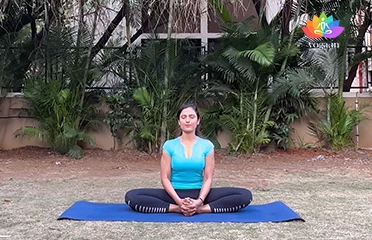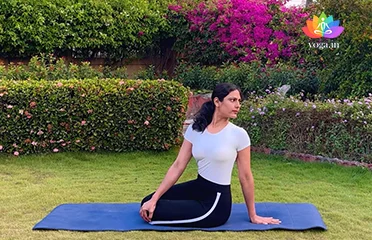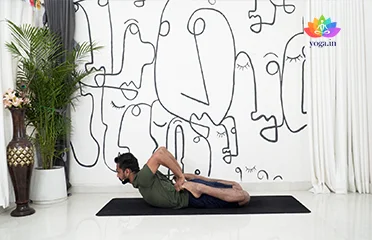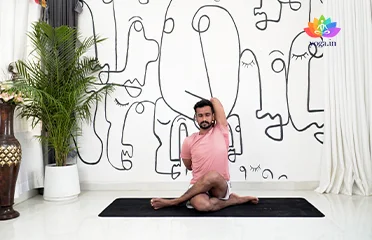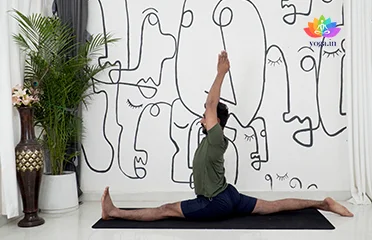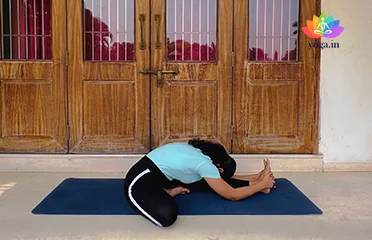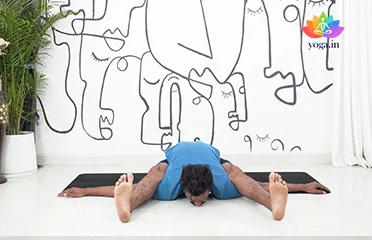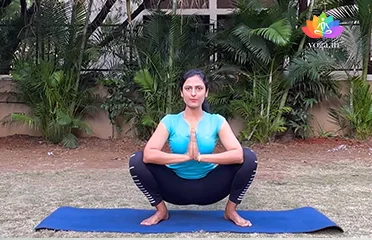Akarna Dhanurasana (Archer Pose)
अकर्णा धनुरासन / Archer Pose
The Sanskrit name is derived from Akarna (अकर्णा ) meaning towards [�K]
Balasana (Child’s Pose)
बालासना / Child's Pose
The Sanskrit name is derived from Bala (बाला) meaning child and āsana [�K]
Bhadrasana (Gracious Pose | Butterfly Po
भद्रासन / Gracious Pose | Butterfly Pose
The Sanskrit name is derived from Bhadra (भद्रा) meaning gracious, [�K]
Bharadvajasana (Seated Spinal Twist)
भरद्वाजसन / Seated Spinal Twist
The Sanskrit name is derived from Bhardvaja (भरद्वाज) means bringing [�K]
Bhekasana (Frog Pose II)
भेकासन / Frog Pose II
The Sanskrit name is derived from Bheka (भेका) meaning frog and asana [�K]
Gomukhasana (Cow Face Pose)
गोमुखासन / Cow Face Pose
The Sanskrit name is derived from Gau (गो) meaning cow, Mukh meaning face [�K]
Hanumanasana (Monkey Pose)
हनुमानासन / Monkey Pose
The Sanskrit name is derived from the Hindu God -Hanuman (हनुमान) [�K]
Janusirsasana (Head to Knee Pose)
जानुशीर्षासन / Head to Knee Pose
The Sanskrit name is derived from (जानु) Janu means knee, Sirsa (शीर्षा) [�K]
Kurmasana (Tortoise Pose)
कूर्मासन / Tortoise Pose
The Sanskrit name is derived from Kurma (कूर्मा) meaning tortoise [�K]
Malasana (Garland Pose)
मालासना / Garland Pose
The Sanskrit name is derived from Mala (माला) means garland or rosary [�K]
- 1
- 2
Knee Pain – Relief Through Yoga and a Holistic Approach
Knee pain, a common yet frustrating issue, can significantly impact your mobility and daily life. From persistent aches to limited movement, it can range from mildly annoying to severely debilitating. It’s crucial to address knee pain because it directly affects your ability to move freely and maintain an active lifestyle.
Understanding the Enemy: Common Causes of Knee Pain
Several culprits can contribute to knee pain. Here are some of the most frequent offenders:
- Osteoarthritis: This age-related condition involves the gradual wear and tear of the cartilage cushioning your knee joint.
- Ligament Injuries: Sprains or tears in the ligaments that stabilize your knee joint can cause significant pain and instability.
- Meniscus Tears: These occur when the cartilage discs within the knee joint sustain damage, affecting shock absorption and movement.
- Tendonitis: Inflammation of the tendons surrounding your knee joint can lead to pain and tenderness.
- Overuse or Strain: Repetitive stress from activities like running or squatting can overload the knee joint, causing pain and discomfort.
Yoga and Pranayama – Gentle Allies for Knee Pain Relief
Fortunately, you don’t have to fight knee pain alone. Yoga and Pranayama (breathing exercises) offer a gentle yet effective approach to manage knee pain. Here’s how they can help:
- Strengthening Muscles: Specific yoga poses target and strengthen the muscles around your knee joint, improving stability and support. This reduces stress on the joint itself, alleviating pain and preventing future injuries.
- Enhanced Flexibility: Yoga poses gently stretch and increase the range of motion in your knee joint. This improves your overall flexibility and reduces stiffness, making daily activities easier and more comfortable.
- Improved Joint Health: Yoga postures promote healthy circulation, which brings essential nutrients to the knee joint and helps remove waste products. This can contribute to overall joint health and pain reduction.
Optimizing Your Journey – A Holistic Approach to Knee Pain Management
While yoga and Pranayama offer significant benefits, a holistic approach is key for managing knee pain effectively. Here are some additional tips:
- Diet for Knee Health: Focus on anti-inflammatory foods like fruits, vegetables, and fatty fish. Consume calcium-rich options for bone health and consider incorporating turmeric and ginger for their anti-inflammatory properties. Maintaining a healthy weight also reduces stress on your knee joints.
- Mindful Practice: When practicing yoga, prioritize mindful movement and avoid abrupt or extreme knee positions. Listen to your body and modify poses as needed to ensure comfort and safety.
- Seeking Professional Guidance: If the pain persists or worsens during yoga, consult a healthcare professional. They can assess your condition and recommend the most suitable yoga poses and modifications.
Contraindications – Who Should Approach with Caution
While yoga is generally safe for most, there are some situations where caution is advised:
- Severe Knee Pain or Recent Surgery: If you have severe knee pain or have recently undergone knee surgery, consult your doctor before starting yoga.
- Acute Inflammation or Instability: If your knee is acutely inflamed or unstable, avoid yoga until the condition improves.
- Pre-existing Conditions: If you have any pre-existing knee conditions, discuss yoga practice with your healthcare professional first.
- Pregnancy: Pregnant women should modify yoga poses and consult with their doctor before practicing.
By understanding the causes of knee pain, incorporating yoga and Pranayama into your routine, maintaining a healthy diet, and practicing with caution, you can effectively manage knee pain and work towards a more active and comfortable life. Remember, consistency and a holistic approach are key to achieving lasting results.


